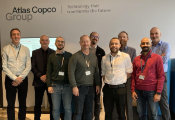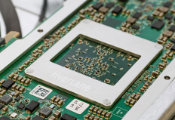Innovative Optical Tweezers Technique Discovers Novel Disease Indicators in Aging Animals
January 02, 2025 -- When materials are subjected to mechanical stresses, they can deform elastically like solid rubbers or they tend to flow like viscous liquids. The branch of physics that studies how materials respond is called rheology. Biological materials, however, are neither a purely elastic or viscous material – they are said to be viscoelastic. This means, their viscoelastic properties depend on the velocity at which they are deformed (imagine silly putty), and the strains depend on how long the stresses last.
In biology, changes in viscoelasticity can lead to severe diseases, such as cancers. Thus, knowing the viscoelasticity and other rheological properties of biological samples, such as intracellular organelles, cells or entire tissues, is central to understanding their physiological function. In addition to fundamental knowledge, that could provide practical benefits, such as the acceleration of drug discovery or diagnosis of diseases. Moreover, the rheological properties of everyday materials are important for food processing and the texture of chewing gum, but also tooth paste and the lubrication of mechanical elements in the car.
ICFO researchers Dr. Frederic Català-Castro, Santiago Ortiz-Vázquez, Dr. Carmen Martínez-Fernández, Martín Fernández-Campo, Dr. Neus Sanfeliu-Cerdán, led by Prof. Dr. Michael Krieg, along with Dr. Paolo-Antonio Frigeri from Impetux Optics and collaborators from multiple institutes (Center of Genomic Regulation, Institute for Research in Biomedicine and Universitat Pompeu Fabra), have developed a novel optical tweezer method to characterize rheological properties. This approach, published in Nature Nanotechnology, allows for more versatile, simplified measurements of the rheological properties of cells, tissues, and organelles, improving upon previous techniques. Thanks to this technique, the team has shown, for the first time, how different organelles inside developing stem cells have varying mechanical properties and how age influences the viscoelasticity of tissues inside living animals.
Democratizing optical tweezers-based rheology
Optical tweezers are scientific instruments that use a highly focused laser beam to hold and move atoms, nanoparticles or micron-sized particles. As the name itself suggests, they are like tweezers made of light, and they allow one to manipulate microscopic objects in a controllable way. Interestingly, they can be used to palpate the cell-scale world, allowing to pull from a cell membrane, push the cell nucleus, deform a protein condensate, or sense how stiff or fluid the cytoplasm is.
Despite being particularly well suited to derive material properties of biological materials, former optical tweezer-based techniques aimed at the study of rheology face a practical issue: a complicated experimental set-up, including a perfectly aligned dual laser system that requires a full-time technician, is needed. This is prohibitive for most biological laboratories. In fact, just a few research sites worldwide have been able to employ this kind of technology in their studies so far.
To empower any researcher with the will to characterize the microrheological properties of their sample, the team has developed a time-shared optical tweezers microrheology (in short, TimSOM) method. Their approach only requires a single laser, which simplifies the complexity of the set-up and enhances considerably the versatility of the technique. “At the same time, TimSOM is accompanied by a step-by-step protocol on how to use it, which will facilitate the adoption of optical tweezers-based microrheology in the fields of molecular, cellular and developmental biology”, shares ICFO Prof. Michael Krieg.
But the study did not only present the practical aspects of TimSOM, but also proved its enhanced ability to measure stress and strain in biological samples and, consequently, to retrieve their rheological properties. This way, researchers unveiled three novel phenomena.
Three novel results for mechanobiology
First, the team focused their attention on a protein condensate, which is known to undergo an age-dependent transition from a liquid to a more solid state. Over the past years, such phase transition has received ample interest, as it is related to neurodegenerative diseases. Using TimSOM, researchers were surprised to see that the viscoelasticity inside the protein condensate was substantially higher than that at the interface after maturation, suggestive for a potential mechanism of the maturation process.
To demonstrate TimSOM in living cells, the team then turned to cells isolated from developing zebrafish embryos and even intact animals. They tackled the question whether or not different cellular organelles have distinct mechanical properties, when directly probed from the inside. The TimSOM technique successfully retrieved information in this regard: when the team measured the interface between the nucleus and the cytoplasm (the material inside the cell membrane), they obtained a much higher viscoelasticity compared to the cytoplasm. Moreover, researchers were also able to measure the rheology of the nucleoplasm (the content inside the nucleus). Contrary to everyone’s expectations, it turned out that it was extremely soft.
Encouraged by these results, researchers then wanted to find out whether their technique could be applied inside a living animal. They chose Caenorhabditis elegans, a 1-millimeter-long warm, and explored the relation between viscoelasticity and ageing in its intestinal tissues. TimSOM showed that viscoelasticity changes upon ageing, as well as after mutations of the nuclear envelope that accelerate ageing occur.
A single laser technique: advantages and challenges
All these successes were possible thanks to the simplified scheme of the TimSOM technique, which only required a single laser beam. The laser was split into two optical tweezers that trapped the particle under study. One of them applied a force on it (stress) and the other detected the consequent displacement (strain).
Going from two to one laser beams reduced instrumentation complexity, material expenditure and measurement time, among other advantages. According to first co-author Frederic Catala-Castro: “Because we used the same laser, our measurements were easy to conduct at different locations within the same living cells, which otherwise are notoriously difficult to perform. In other words, the single laser optical trap can be displaced at any position in the field of view, which enhances the spatiotemporal versatility of this method.”
However, the use of a single, time-shared laser faced one main drawback. “Time-sharing means that the same laser half of the time measures the force and the other half measures the particle displacement due to this force”, explains Dr. Paolo-Antonio Frigeri, former researcher at Impetux Optics and co-inventor of the technique. As a consequence, the stress and strain measurements were quasi-simultaneous, but not at the exact same time. To circumvent this obstacle, the team developed a new theoretical framework to obtain the viscoelastic parameters and retrieve the missing data from the raw measurements.
Future applications in material characterization and fundamental insights in rheology
Having solved this main issue and given the TimSOM’s demonstrated potential through the novel reported results, the technique is ready to be applied to many different fields involving material characterization. As only small sample volumes are required, TimSOM is particularly useful to quantify the rheological properties of precious and rare materials. Thus, it suited for industrial applications that need to characterize emulsions, blends, protein droplets and other biologically derived liquids, for instance, in the food processing industry, cosmetics or pharmaceutics.
Prof. Krieg, though, is even more excited about the information in fundamental science that could be unlocked: “Which is the energy that a cell requires in order to move? How does the nucleus protect DNA and activate transcription? How does the deformation of a mechanosensitive protein condensate translate into the activation of a neuron? TimSOM will help scientists in the field take a picture of biological mechanics, a stiffness map of a biomaterial, and luckily that might allow us to finally answer these and many other long-lived questions in rheology.”




































